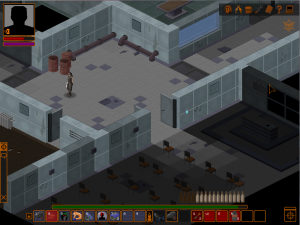 Malcolm Armstrong looks at this Fallout-inspired retro release that’s currently in Alpha.
Malcolm Armstrong looks at this Fallout-inspired retro release that’s currently in Alpha.
Underrail is an isometric turn based RPG using the standard point & click and quick keys to control the game, the kind you’d expect from such classics as Baldur’s Gate or Fallout. In that sense it offers a very respectable nod to its predecessors, as even in its alpha stage the game feels polished. Thematically it seems to have a go at recreating Fallout as well, and at that it does itself proud. The art work is gritty, the buildings are decrepit, the rats are huge and the scorpions are rad..ical. (Okay that was a joke, it doesn’t veer that closely to the classic). Combined with the music (it’s more ambient noise than music) it all comes together to build a believably desolate and bleak world.
 Character creation is a highly varied and empowering tool in Underrail. First off there are base line feats – Strength, Dexterity, Intelligence, you know the drill. As expected, these initially shape the character and influence the skills that you go on to invest in. There are twenty two skills to choose from and develop, and, much like the statistics, each one has its own integral value in improving and defining your character. These skills are separated into six major disciplines: Combat, Defense, Subterfuge, Science, Psionics and Social. Lastly there are feats – one time choices that further improve your character and guide them down specific builds.
Character creation is a highly varied and empowering tool in Underrail. First off there are base line feats – Strength, Dexterity, Intelligence, you know the drill. As expected, these initially shape the character and influence the skills that you go on to invest in. There are twenty two skills to choose from and develop, and, much like the statistics, each one has its own integral value in improving and defining your character. These skills are separated into six major disciplines: Combat, Defense, Subterfuge, Science, Psionics and Social. Lastly there are feats – one time choices that further improve your character and guide them down specific builds.
This can all seem quite overwhelming initially – all those skills, where do you start? And those feats on top, it’s all too much surely? The beautiful thing about the skills however is that many of them synergize with each other, which helps lead a newer player into avoiding the traps of making a terrible character. As for the feats well, would it surprise you if I told you there were pre-requisites to attaining a lot of these feats thus making the choices fairly simple? No? Didn’t think so.
 Crafting in Underrail is a powerful tool. Based off the Science discipline, it lets you create nearly any useful item in the game out of base components that you can either find in the wilderness or buy from vendors. The creation of these items is based off each skill inside the Science discipline – Investing in Mechanics and Electronics means you can create better guns and tools, increasing your ability in Biology and Chemistry lets you create healing items and explosives whilst buying up Leatherworking lets you make better armours for your character. All these crafts can either be used for self-consumption or to make a profit from the vendors, making them a viable skill tree to buy into for a character path.
Crafting in Underrail is a powerful tool. Based off the Science discipline, it lets you create nearly any useful item in the game out of base components that you can either find in the wilderness or buy from vendors. The creation of these items is based off each skill inside the Science discipline – Investing in Mechanics and Electronics means you can create better guns and tools, increasing your ability in Biology and Chemistry lets you create healing items and explosives whilst buying up Leatherworking lets you make better armours for your character. All these crafts can either be used for self-consumption or to make a profit from the vendors, making them a viable skill tree to buy into for a character path.
The other unique aspect of the game is Psionics, though it currently simply offers an alternative to the traditional weaponry expected in this kind of game. Through the three skills available in Psionics, you can develop strong spell based attacks which are regulated by your character’s Psi (Mana) bar. These skills can be developed in addition to your normal weapon skills and used in addition to them in normal combat, meaning you can assault your enemies with bullets or with mental breakdowns… or you can just burn them to a crisp if that’s your fancy.
 The pacing of the story in Underrail is fairly well done; nothing feels too rushed and you never feel like you’re being dragged along at a snail’s pace. In contrast to this, the general difficulty is unrelenting. Combat is brutal – a single mistake in battle can prove fatal, as can being overly confident in your powers. To this end you’ll find your fingers hovering over the quick save and quick load keys almost from the get go. This can be interpreted in either a bad or good way, it all depends on whether you like the challenge or not.
The pacing of the story in Underrail is fairly well done; nothing feels too rushed and you never feel like you’re being dragged along at a snail’s pace. In contrast to this, the general difficulty is unrelenting. Combat is brutal – a single mistake in battle can prove fatal, as can being overly confident in your powers. To this end you’ll find your fingers hovering over the quick save and quick load keys almost from the get go. This can be interpreted in either a bad or good way, it all depends on whether you like the challenge or not.
The only real criticism that can be said of Underrail (besides possibly the difficulty) is that it is sometimes confusing knowing where to go next. Directions from quest givers are only given once, and the journal your character keeps is unfortunately sparse when it comes to saying which area you should be in. For me this meant I spent a good half hour walking around the same three areas trying to figure out what I was missing, until I finally figured out there was another exit on the other side of the starting base and that I had gone completely the wrong way. Additionally the game lacks a few polishing features such as a lack of outlines on enemies during combat, making it pretty hard to see where they are and where you need to shoot. Keeping in mind this is an alpha, that’s a problem that could be easily solved before full release.
All in all Underrail is a solid game and if you are a fan of RPGs at all you should definitely try this out. Post-apocalyptic isometric RPG’s are back!
